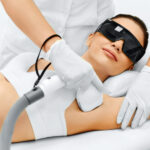Cryolipolysis and Cavitation are two recognized beneficial treatments to aid in fat removal by using non-surgical technology. Both of these procedures facilitate the disruption of cells to remove fat deposits in the areas of concern. Lipo cavitation is a method that destroys fat cells via low-frequency sound waves whereas cryolipolysis, also known as fat freezing, uses cooling mechanisms to break down fat cells.
What are popular options to lose weight?
There are numerous ways in which people can achieve weight loss. There are mechanical methods that remove adipose tissue that are surgically invasive or there are non-invasive procedures such as liposuction, cryolipolysis, and cavitation treatment. Alternatively, some people choose to achieve weight loss naturally through means of physical exercise and calorie deficit eating habits.
With non-invasive weight loss options becoming increasingly convenient and common, it is no surprise that cavitation and cryolipolysis in London have become significantly popular weight loss and fat removal treatments. These procedures are painless requiring no recovery time while simultaneously helping you transform your body.
What is cryolipolysis (fat freezing)?
Cryolipolysis, known as fat freezing, is a non-invasive procedure applied to problematic areas of the body in which a cooling process is used to provide localized fat reduction. As the name states, it involves freezing of the fat cells, causing them to eventually die off. The fat pocket that is targeted is frozen. Here, around 30% of the cells die off and the released fats, membranes, and toxins that were contained inside the fat cells are eliminated via the body’s lymphatic system.
What is cavitation (fat melting)?
Cavitation (liposuction) treatment is also known as ultrasonic cavitation, and it is a non-invasive method of liposuction treatment. In this procedure, low-frequency sound waves are produced and applied to the targeted area, which causes the fat cells to oscillate rapidly, resulting in a pressure build up within the fat cells. Once pressure is at its threshold, the fat cells break apart and the contents are released into the body.

What are the main differences between these procedures?
Even though both treatments facilitate the removal of fat in the body, the main difference is in the method of procedure. Ultrasonic cavitation is quite different from cryolipolysis in which the fat reduction method involves the application of ultrasound and low-frequency sound waves to achieve its effect.
This serves as an effective method in treating cellulite, more widespread fat and cavitation achieves body contouring results. In contrast, cryolipolysis operates with controlled low temperatures on the area of concern and is far more suitable and effective in treating more specific fat accumulation and fat pockets that can be grabbed.
Each cavitation fat treatment session lasts approximately 40 minutes to 1 hour and 6-12 treatments with a 5-7 day period between each session are recommended for optimal results (removal of up to 12cm of fat). These results vary from person to person and patients often see a big difference in the reduction of fat within 6-12 weeks.
Cryolipolysis, on the other hand, is a once off, 45-minute to 1 hour treatment that can take 6-10 weeks to see full results. A more effective outcome can be combined with dietary factors as well.
The results of cavitation/fat melting treatment are perceived to appear faster as opposed to cryolipolysis, where results only start to appear and be noticeable after a month of treatment. However, the results of cryolipolysis are more stable and long term compared to cavitation. Cavitation requires a greater number of treatment sessions to achieve similar effects.
Is lipo cavitation safe? Yes, and so is cavitation. Both procedures are pain-free with very few risks. The possible side effects of cavitation may include bruising, slight skin irritation and/or presentation of a pink colour on the treated area of the skin. With cryolipolysis, bruising, numbness of the area and/or pigmentation can occur as a result of treatment.

How are they conducted?
Cavitation is administered with the use of an ultrasound device and a paddle type applicator. Here, low frequency ultrasonic waves are applied using the applicator over the fatty tissue. The ultrasound waves penetrate deep into the layers of the skin and produce fine ultrasonic vibrations within the fat cells. This causes the fat cells to break away from each other and are eventually absorbed by your lymphatic system.
With cryolipolysis, a Cryo Head is used and placed over the fatty pocket. This machine physically sucks up the pocket of fat and freezes it to approximately -6°C. This cooling technique penetrates about 2cm below the surface of the skin, freezing the fat cells and causing them to die off. This reduces the amount of adipose tissue by interrupting the homeostatic temperature of the epidermis.
What are the benefits of both cryolipolysis and cavitation?
Cavitation and cryolipolysis at clinics are non-invasive and non-surgical procedures that require no anaesthetics and often have minimal to no side effects. Depending on the method you chose, cavitation targets a reduction in widespread fat and aids in cellulite reduction whereas cryolipolysis offers permanent reduction of specific fat pockets on the body. All in all, they both facilitate in the reduction of localized fat through a pain-free application, leaving no scarring or marks while also tightening the skin. A great advantage is that both procedures allow you to continue with your normal daily activities immediately after the treatment process with zero downtime required.
What to expect from them?
Through these procedures, one can expect a reduction in localized or widespread fat and/or contouring of certain body parts while treating cellulite and improving skin elasticity. Most of these results are relatively permanent with the correct healthy eating habits put in place to improve maintenance. During the procedure, some may experience slight discomfort due to the ultrasonic noise from the fat freezing or a cold sensation from the cryolipolysis machines, however, this inflicts no harm on the patient.
Latest News
- August 25, 2021
- August 25, 2021
- July 21, 2021
- July 20, 2021
- June 21, 2021





